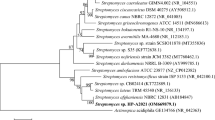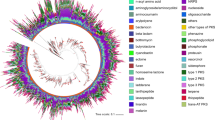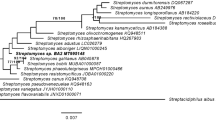Abstract
Since the discovery of the streptomycin produced by Streptomyces griseus in the middle of the last century, members of this bacterial genus have been largely exploited for the production of secondary metabolites with wide uses in medicine and in agriculture. They have even been recognized as one of the most prolific producers of natural products among microorganisms. With the onset of the genomic era, it became evident that these microorganisms still represent a major source for the discovery of novel secondary metabolites. This was highlighted with the complete genome sequencing of Streptomyces coelicolor A3(2) which revealed an unexpected potential of this organism to synthesize natural products undetected until then by classical screening methods. Since then, analysis of sequenced genomes from numerous Streptomyces species has shown that a single species can carry more than 30 secondary metabolite gene clusters, reinforcing the idea that the biosynthetic potential of this bacterial genus is far from being fully exploited. This review highlights our knowledge on the potential of Streptomyces ambofaciens ATCC 23877 to synthesize natural products. This industrial strain was known for decades to only produce the drug spiramycin and another antibacterial compound, congocidine. Mining of its genome allowed the identification of 23 clusters potentially involved in the production of other secondary metabolites. Studies of some of these clusters resulted in the characterization of novel compounds and of previously known compounds but never characterized in this Streptomyces species. In addition, genome mining revealed that secondary metabolite gene clusters of phylogenetically closely related Streptomyces are mainly species-specific.






Similar content being viewed by others
References
Aigle B, Bunet R, Corre C, Garénaux A, Hotel L, Huang S, Laureti L, Lautru S, Mendes MV, Nezbedova S, Nguyen HC, Song L, Weiser J, Challis G, Leblond P, Pernodet JL (2011) Genome-guided exploration of Streptomyces ambofaciens secondary metabolism. In: Dyson P (ed) Streptomyces, molecular biology and biotechnology. Caister Academic, Norfolk, pp 179–194
Aigle B, Corre C (2012) Waking up Streptomyces secondary metabolism by constitutive expression of activators or genetic disruption of repressors. Methods Enzymol 517:343–366. doi:10.1016/B978-0-12-404634-4.00017-6
Aigle B, Pang X, Decaris B, Leblond P (2005) Involvement of AlpV, a new member of the Streptomyces antibiotic regulatory protein family, in regulation of the duplicated type II polyketide synthase alp gene cluster in Streptomyces ambofaciens. J Bacteriol 187(7):2491–2500. doi:10.1128/JB.187.7.2491-2500.2005
Baltz R (2007) Antimicrobials from actinomycetes: back to the future. Microbe 2(3):125–131
Barona-Gomez F, Lautru S, Francou FX, Leblond P, Pernodet JL, Challis GL (2006) Multiple biosynthetic and uptake systems mediate siderophore-dependent iron acquisition in Streptomyces coelicolor A3(2) and Streptomyces ambofaciens ATCC 23877. Microbiology 152(Pt 11):3355–3366. doi:10.1099/mic.0.29161-0
Barona-Gomez F, Wong U, Giannakopulos AE, Derrick PJ, Challis GL (2004) Identification of a cluster of genes that directs desferrioxamine biosynthesis in Streptomyces coelicolor M145. J Am Chem Soc 126(50):16282–16283. doi:10.1021/ja045774k
Bentley SD, Chater KF, Cerdeno-Tarraga AM, Challis GL, Thomson NR, James KD, Harris DE, Quail MA, Kieser H, Harper D, Bateman A, Brown S, Chandra G, Chen CW, Collins M, Cronin A, Fraser A, Goble A, Hidalgo J, Hornsby T, Howarth S, Huang CH, Kieser T, Larke L, Murphy L, Oliver K, O’Neil S, Rabbinowitsch E, Rajandream MA, Rutherford K, Rutter S, Seeger K, Saunders D, Sharp S, Squares R, Squares S, Taylor K, Warren T, Wietzorrek A, Woodward J, Barrell BG, Parkhill J, Hopwood DA (2002) Complete genome sequence of the model actinomycete Streptomyces coelicolor A3(2). Nature 417(6885):141–147. doi:10.1038/417141a
Bergmann S, Schumann J, Scherlach K, Lange C, Brakhage AA, Hertweck C (2007) Genomics-driven discovery of PKS-NRPS hybrid metabolites from Aspergillus nidulans. Nat Chem Biol 3(4):213–217. doi:10.1038/nchembio869
Bisang C, Long PF, Cortes J, Westcott J, Crosby J, Matharu AL, Cox RJ, Simpson TJ, Staunton J, Leadlay PF (1999) A chain initiation factor common to both modular and aromatic polyketide synthases. Nature 401(6752):502–505. doi:10.1038/46829
Bunet R, Mendes MV, Rouhier N, Pang X, Hotel L, Leblond P, Aigle B (2008) Regulation of the synthesis of the angucyclinone antibiotic alpomycin in Streptomyces ambofaciens by the autoregulator receptor AlpZ and its specific ligand. J Bacteriol 190(9):3293–3305. doi:10.1128/JB.01989-07
Bunet R, Song L, Mendes MV, Corre C, Hotel L, Rouhier N, Framboisier X, Leblond P, Challis GL, Aigle B (2011) Characterization and manipulation of the pathway-specific late regulator AlpW reveals Streptomyces ambofaciens as a new producer of kinamycins. J Bacteriol 193(5):1142–1153. doi:10.1128/JB.01269-10
Chew WK, Segarra I, Ambu S, Mak JW (2012) Significant reduction of brain cysts caused by Toxoplasma gondii after treatment with spiramycin coadministered with metronidazole in a mouse model of chronic toxoplasmosis. Antimicrob Agents Chemother 56(4):1762–1768. doi:10.1128/AAC.05183-11
Choulet F, Aigle B, Gallois A, Mangenot S, Gerbaud C, Truong C, Francou FX, Fourrier C, Guerineau M, Decaris B, Barbe V, Pernodet JL, Leblond P (2006) Evolution of the terminal regions of the Streptomyces linear chromosome. Mol Biol Evol 23(12):2361–2369. doi:10.1093/molbev/msl108
Citron CA, Gleitzmann J, Laurenzano G, Pukall R, Dickschat JS (2012) Terpenoids are widespread in actinomycetes: a correlation of secondary metabolism and genome data. ChemBioChem 13(2):202–214. doi:10.1002/cbic.201100641
Cosar C, Ninet L, Pinnert-Sindico S, Preud’Homme J (1952) Trypanocide action of an antibiotic produced by a Streptomyces. C R Hebd Seances Acad Sci 234(14):1498–1499
Finlay AC, Hochstein FA, Sobin BA, Murphy FX (1951) Netropsin, a new antibiotic produced by a Streptomyces. J Am Chem Soc 73:341–343
Geistlich M, Losick R, Turner JR, Rao RN (1992) Characterization of a novel regulatory gene governing the expression of a polyketide synthase gene in Streptomyces ambofaciens. Mol Microbiol 6(14):2019–2029
Gerber N (1973) Volatile lactones from Streptomyces. Tetrahedron Lett 14(10):771–774
Gokhale RS, Hunziker D, Cane DE, Khosla C (1999) Mechanism and specificity of the terminal thioesterase domain from the erythromycin polyketide synthase. Chem Biol 6(2):117–125. doi:10.1016/S1074-5521(99)80008-8
Gomez-Escrabino J, Song L, Fox D, Yeo V, Bibb M, Challis G (2012) Structure and biosynthesis of the unusual polyketide alkaloid coelimycin P1, a metabolic product of the cpk gene cluster of Streptomyces coelicolor M145. Chem Sci 3:2716–2720
Gomez-Escribano JP, Bibb MJ (2012) Streptomyces coelicolor as an expression host for heterologous gene clusters. Methods Enzymol 517:279–300. doi:10.1016/B978-0-12-404634-4.00014-0
Gomez-Escribano JP, Bibb MJ (2013) Heterologous expression of natural product biosynthetic gene clusters in Streptomyces coelicolor: from genome mining to manipulation of biosynthetic pathways. J Ind Microbiol Biotechnol. doi:10.1007/s10295-013-1348-5
Gould SJ (1997) Biosynthesis of the kinamycins. Chem Rev 97(7):2499–2510
Gould SJ, Hong ST, Carney JR (1998) Cloning and heterologous expression of genes from the kinamycin biosynthetic pathway of Streptomyces murayamaensis. J Antibiot (Tokyo) 51(1):50–57
Hasinoff BB, Wu X, Yalowich JC, Goodfellow V, Laufer RS, Adedayo O, Dmitrienko GI (2006) Kinamycins A and C, bacterial metabolites that contain an unusual diazo group, as potential new anticancer agents: antiproliferative and cell cycle effects. Anticancer Drugs 17(7):825–837
Juguet M, Lautru S, Francou FX, Nezbedova S, Leblond P, Gondry M, Pernodet JL (2009) An iterative nonribosomal peptide synthetase assembles the pyrrole-amide antibiotic congocidine in Streptomyces ambofaciens. Chem Biol 16(4):421–431. doi:10.1016/j.chembiol.2009.03.010
Kaiser S, Muller JJ, Froehlich PE, Baggio Gnoatto SC, Bergold AM (2013) From bacteria to antineoplastic: epothilones a successful history. Anticancer Agents Med Chem 13(7):1057–1068
Kamra P, Gokhale RS, Mohanty D (2005) SEARCHGTr: a program for analysis of glycosyltransferases involved in glycosylation of secondary metabolites. Nucleic Acids Res 33 (Web Server issue):W220–W225. doi:10.1093/nar/gki449
Karray F, Darbon E, Nguyen HC, Gagnat J, Pernodet JL (2010) Regulation of the biosynthesis of the macrolide antibiotic spiramycin in Streptomyces ambofaciens. J Bacteriol 192(21):5813–5821. doi:10.1128/JB.00712-10
Karray F, Darbon E, Oestreicher N, Dominguez H, Tuphile K, Gagnat J, Blondelet-Rouault MH, Gerbaud C, Pernodet JL (2007) Organization of the biosynthetic gene cluster for the macrolide antibiotic spiramycin in Streptomyces ambofaciens. Microbiology 153(Pt 12):4111–4122. doi:10.1099/mic.0.2007/009746-0
Keatinge-Clay AT (2007) A tylosin ketoreductase reveals how chirality is determined in polyketides. Chem Biol 14(8):898–908. doi:10.1016/j.chembiol.2007.07.009
Kelly WL, Pan L, Li C (2009) Thiostrepton biosynthesis: prototype for a new family of bacteriocins. J Am Chem Soc 131(12):4327–4334. doi:10.1021/ja807890a
Kim BS, Cropp TA, Beck BJ, Sherman DH, Reynolds KA (2002) Biochemical evidence for an editing role of thioesterase II in the biosynthesis of the polyketide pikromycin. J Biol Chem 277(50):48028–48034. doi:10.1074/jbc.M207770200
Kuhstoss S, Huber M, Turner JR, Paschal JW, Rao RN (1996) Production of a novel polyketide through the construction of a hybrid polyketide synthase. Gene 183(1–2):231–236
Kuscer E, Coates N, Challis I, Gregory M, Wilkinson B, Sheridan R, Petkovic H (2007) Roles of rapH and rapG in positive regulation of rapamycin biosynthesis in Streptomyces hygroscopicus. J Bacteriol 189(13):4756–4763. doi:10.1128/JB.00129-07
Kwan DH, Sun Y, Schulz F, Hong H, Popovic B, Sim-Stark JC, Haydock SF, Leadlay PF (2008) Prediction and manipulation of the stereochemistry of enoylreduction in modular polyketide synthases. Chem Biol 15(11):1231–1240. doi:10.1016/j.chembiol.2008.09.012
Laureti L, Song L, Huang S, Corre C, Leblond P, Challis GL, Aigle B (2011) Identification of a bioactive 51-membered macrolide complex by activation of a silent polyketide synthase in Streptomyces ambofaciens. Proc Natl Acad Sci U S A 108(15):6258–6263. doi:10.1073/pnas.1019077108
Lautru S, Deeth RJ, Bailey LM, Challis GL (2005) Discovery of a new peptide natural product by Streptomyces coelicolor genome mining. Nat Chem Biol 1(5):265–269. doi:10.1038/nchembio731
Lautru S, Gondry M, Genet R, Pernodet JL (2002) The albonoursin gene cluster of S noursei biosynthesis of diketopiperazine metabolites independent of nonribosomal peptide synthetases. Chem Biol 9(12):1355–1364
Lautru S, Song L, Demange L, Lombes T, Galons H, Challis GL, Pernodet JL (2012) A sweet origin for the key congocidine precursor 4-acetamidopyrrole-2-carboxylate. Angew Chem Int Ed Engl 51(30):7454–7458. doi:10.1002/anie.201201445
Leben C, Keitt G (1948) An antibiotic substance active against certain phytopathogens. Phytopathology 38:899–906
Leblond P, Demuyter P, Simonet JM, Decaris B (1991) Genetic instability and associated genome plasticity in Streptomyces ambofaciens: pulsed-field gel electrophoresis evidence for large DNA alterations in a limited genomic region. J Bacteriol 173(13):4229–4233
Lee SJ, Kim EA, Song KS, Kim MJ, Lee DH, Kwon TK, Lee TJ (2012) Antimycin A sensitizes cells to TRAIL-induced apoptosis through upregulation of DR5 and downregulation of c-FLIP and Bcl-2. Int J Oncol 41(4):1425–1430. doi:10.3892/ijo2012.1575
Li MH, Ung PM, Zajkowski J, Garneau-Tsodikova S, Sherman DH (2009) Automated genome mining for natural products. BMC Bioinformatics 10:185. doi:10.1186/1471-2105-10-185
Medema MH, Blin K, Cimermancic P, de Jager V, Zakrzewski P, Fischbach MA, Weber T, Takano E, Breitling R (2011) antiSMASH: rapid identification, annotation and analysis of secondary metabolite biosynthesis gene clusters in bacterial and fungal genome sequences. Nucleic Acids Res 39 (Web Server issue):W339–W346. doi:10.1093/nar/gkr466
Medema MH, Trefzer A, Kovalchuk A, van den Berg M, Muller U, Heijne W, Wu L, Alam MT, Ronning CM, Nierman WC, Bovenberg RA, Breitling R, Takano E (2010) The sequence of a 1.8-mb bacterial linear plasmid reveals a rich evolutionary reservoir of secondary metabolic pathways. Genome Biol Evol 2:212–224. doi:10.1093/gbe/evq013
Mochizuki S, Hiratsu K, Suwa M, Ishii T, Sugino F, Yamada K, Kinashi H (2003) The large linear plasmid pSLA2-L of Streptomyces rochei has an unusually condensed gene organization for secondary metabolism. Mol Microbiol 48(6):1501–1510
Moore JM, Bradshaw E, Seipke RF, Hutchings MI, McArthur M (2012) Use and discovery of chemical elicitors that stimulate biosynthetic gene clusters in Streptomyces bacteria. Methods Enzymol 517:367–385. doi:10.1016/B978-0-12-404634-4.00018-8
Nguyen HC, Darbon E, Thai R, Pernodet JL, Lautru S (2013) Post-PKS tailoring steps of the spiramycin macrolactone ring in Streptomyces ambofaciens. Antimicrob Agents Chemother 57(8):3836–3842. doi:10.1128/AAC.00512-13
Nguyen HC, Karray F, Lautru S, Gagnat J, Lebrihi A, Huynh TD, Pernodet JL (2010) Glycosylation steps during spiramycin biosynthesis in Streptomyces ambofaciens: involvement of three glycosyltransferases and their interplay with two auxiliary proteins. Antimicrob Agents Chemother 54(7):2830–2839. doi:10.1128/AAC.01602-09
O’Hara KA, Dmitrienko GI, Hasinoff BB (2010) Kinamycin F downregulates cyclin D3 in human leukemia K562 cells. Chem Biol Interact 184(3):396–402. doi:10.1016/j.cbi.2010.01.013
Ochi K, Hosaka T (2013) New strategies for drug discovery: activation of silent or weakly expressed microbial gene clusters. Appl Microbiol Biotechnol 97(1):87–98. doi:10.1007/s00253-012-4551-9
Ochi K, Tanaka Y, Tojo S (2013) Activating the expression of bacterial cryptic genes by rpoB mutations in RNA polymerase or by rare earth elements. J Ind Microbiol Biotechnol. doi:10.1007/s10295-013-1349-4
Pang X, Aigle B, Girardet JM, Mangenot S, Pernodet JL, Decaris B, Leblond P (2004) Functional angucycline-like antibiotic gene cluster in the terminal inverted repeats of the Streptomyces ambofaciens linear chromosome. Antimicrob Agents Chemother 48(2):575–588
Parajuli N, Basnet DB, Chan Lee H, Sohng JK, Liou K (2004) Genome analyses of Streptomyces peucetius ATCC 27952 for the identification and comparison of cytochrome P450 complement with other Streptomyces. Arch Biochem Biophys 425(2):233–241. doi:10.1016/j.abb.2004.03.011
Pinnert-Sindico S (1954) Une nouvelle espèce de Streptomyces productrice d’antibiotiques: Streptomyces ambofaciens n. sp. caractères culturaux. Ann Inst Pasteur (Paris) 87(6):702–707
Poulet PP, Duffaut D, Barthet P, Brumpt I (2005) Concentrations and in vivo antibacterial activity of spiramycin and metronidazole in patients with periodontitis treated with high-dose metronidazole and the spiramycin/metronidazole combination. J Antimicrob Chemother 55(3):347–351. doi:10.1093/jac/dki013
Rebets Y, Brotz E, Tokovenko B, Luzhetskyy A (2013) Actinomycetes biosynthetic potential: how to bridge in silico and in vivo? J Ind Microbiol Biotechnol. doi:10.1007/s10295-013-1352-9
Reid R, Piagentini M, Rodriguez E, Ashley G, Viswanathan N, Carney J, Santi DV, Hutchinson CR, McDaniel R (2003) A model of structure and catalysis for ketoreductase domains in modular polyketide synthases. Biochemistry 42(1):72–79. doi:10.1021/bi0268706
Richardson MA, Kuhstoss S, Huber ML, Ford L, Godfrey O, Turner JR, Rao RN (1990) Cloning of spiramycin biosynthetic genes and their use in constructing Streptomyces ambofaciens mutants defective in spiramycin biosynthesis. J Bacteriol 172(7):3790–3798
Richardson MA, Kuhstoss S, Solenberg P, Schaus NA, Rao RN (1987) A new shuttle cosmid vector, pKC505, for streptomycetes: its use in the cloning of three different spiramycin-resistance genes from a Streptomyces ambofaciens library. Gene 61(3):231–241
Riclea R, Aigle B, Leblond P, Schoenian I, Spiteller D, Dickschat JS (2012) Volatile lactones from streptomycetes arise via the antimycin biosynthetic pathway. ChemBioChem 13(11):1635–1644. doi:10.1002/cbic.201200260
Schoenian I, Paetz C, Dickschat JS, Aigle B, Leblond P, Spiteller D (2012) An unprecedented 1,2-shift in the biosynthesis of the 3-aminosalicylate moiety of antimycins. ChemBioChem 13(6):769–773. doi:10.1002/cbic.201200033
Seipke RF, Barke J, Brearley C, Hill L, Yu DW, Goss RJ, Hutchings MI (2011) A single Streptomyces symbiont makes multiple antifungals to support the fungus farming ant Acromyrmex octospinosus. PLoS ONE 6(8):e22028. doi:10.1371/journal.pone.0022028
Stumpp T, Himbert S, Altenbuchner J (2005) Cloning of the netropsin resistance genes from Streptomyces flavopersicus NRRL 2820. J Basic Microbiol 45(5):355–362. doi:10.1002/jobm.200410529
Tener G, Merlin Bumpus F, Dunshee B, Strong F (1953) The structure of antimycin A. II. Degradation studies. J Am Chem Soc 75(5):1100–1104
Tener G, van Tamelen E, Strong F (1953) The chemistry of antimycin A. III. Structure of the antimycic acid. J Am Chem Soc 75(15):3623–3625
van Tamelen E, Strong F, Quarck U (1959) The chemistry of antimycin A. IV. Study of the structure of antimycin lactone. J Am Chem Soc 81(3):750–751
van Wezel GP, McDowall KJ (2011) The regulation of the secondary metabolism of Streptomyces: new links and experimental advances. Nat Prod Rep 28(7):1311–1333. doi:10.1039/c1np00003a
Welker M, Dittmann E, von Dohren H (2012) Cyanobacteria as a source of natural products. Methods Enzymol 517:23–46. doi:10.1016/B978-0-12-404634-4.00002-4
Wilkinson CJ, Hughes-Thomas ZA, Martin CJ, Bohm I, Mironenko T, Deacon M, Wheatcroft M, Wirtz G, Staunton J, Leadlay PF (2002) Increasing the efficiency of heterologous promoters in actinomycetes. J Mol Microbiol Biotechnol 4(4):417–426
Wilson DJ, Xue Y, Reynolds KA, Sherman DH (2001) Characterization and analysis of the PikD regulatory factor in the pikromycin biosynthetic pathway of Streptomyces venezuelae. J Bacteriol 183(11):3468–3475. doi:10.1128/JB.183.11.3468-3475.2001
Yadav G, Gokhale RS, Mohanty D (2003) Computational approach for prediction of domain organization and substrate specificity of modular polyketide synthases. J Mol Biol 328(2):335–363
Yadav G, Gokhale RS, Mohanty D (2003) SEARCHPKS: a program for detection and analysis of polyketide synthase domains. Nucleic Acids Res 31(13):3654–3658
Zhu H, Sandiford SK, van Wezel GP (2013) Triggers and cues that activate antibiotic production by actinomycetes. J Ind Microbiol Biotechnol. doi:10.1007/s10295-013-1309-z
Ziemert N, Podell S, Penn K, Badger JH, Allen E, Jensen PR (2012) The natural product domain seeker NaPDoS: a phylogeny based bioinformatic tool to classify secondary metabolite gene diversity. PLoS ONE 7(3):e34064. doi:10.1371/journal.pone.0034064
Acknowledgments
This work was supported by the European Community under the ActinoGEN 6th framework programme (FP6-5224), the French National Research Agency through the Laboratory of Excellence ARBRE (ANR-12- LABXARBRE-01) and the Région Lorraine.
Author information
Authors and Affiliations
Corresponding author
Rights and permissions
About this article
Cite this article
Aigle, B., Lautru, S., Spiteller, D. et al. Genome mining of Streptomyces ambofaciens . J Ind Microbiol Biotechnol 41, 251–263 (2014). https://doi.org/10.1007/s10295-013-1379-y
Received:
Accepted:
Published:
Issue Date:
DOI: https://doi.org/10.1007/s10295-013-1379-y




